March 2011
Thurs 3rd: Wake-up call
Wed 9th: October 10.2
Thurs 10th: Facing the music
Fri 18th: Going astray
Wed 23rd: (Almost) nothing happened
Sat 26th: Quickie
Mon 28th: Whoops!
Weds 30th: Time please
Thurs 3rd: Wake-up call
Too casual by half is a common failing in RR's opening play, and the fault showed itself again when Newcastle visited Stafford in the first division. Seven moves in to a queen's gambit by transposition, RR (white) was comfortable against Ken Wozniak. Cue switching off of brain.
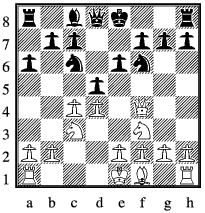
|
| RR v Ken Wozniak after 7 ... a6
|
e3 now looks natural, e4 aggressive, but RR dozily plays h3, as if the queen needs a retreat.
8 h3 dxc4, 9 a4 creating holes, so compounding the error
9 ... Nd5, 10 Qg3 0-0, 11 Rc1 again the position was crying out for e3
11 ... Na5, 12 Ne4 allergic to moving the e-pawn? No surprise with the response.
12 ... b5, 13 Nc5, f6, 14 Nd2 Memo to RR. You have an e-pawn. Move it.
14 ... Nb6, 15 b4 Atrocious. Nc6 and black's queenside win's the game. Fortunately Ken is kind, and the game starts to turn.
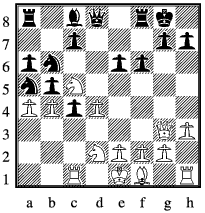
|
| RR v Ken Wozniak after 15 b4
|
15 ... cxb3, 16 Ndxb3 Nxb3, 17 Qxb3 bxa4, 18 Qb4 Defending the d-pawn is more important than taking the a4 pawn.
18 ... a5, 19 Qc3 Nd5, 20 Qa3 Now that the black knight blocks the attack on the d-pawn white has a freer choice for queen placement. a1 might be a better square though as there would then be no opportunity to pin white's knight.
20 ... Bd7, 21 e3 at last!
21 ... Rb8, 22 Nxa4 Bxa4, 23 Qxa4 Ra8, 24 Bc4 Qd6
25 Bxd5 exd5, 26 0-0 Ra6
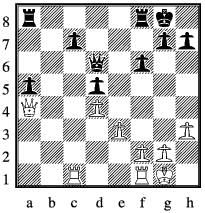
|
| RR v Ken Wozniak after 26 0-0
|
Presumably fearful of Rc6. RR is still a pawn down, but with both an isolated and a backward pawn to line up his heavy artillery against he is feeling happy again.
27 Rc5 Rfa8, 28 Rfc1 Rc8 This fails to protect the c-pawn
29 Rxc7 Rxc7, 30 Rxc7 h6 Qxc7 allows Qe8 mate, hence the previous comment
31 Qe8+ Qf8, 32 Qb5 Qd6 hoping for repetition? 33 Qb7 1-0
comment on this article
Wed 9th: October 10.2
In October when Holmes Chapel Rooks visited Meir A there was a 10.2 claim that couldn't be resolved on the night. As there was some disagreement over exactly what happened it was decided that it would be best to have a meeting so that both sides could be happy that their comments had been heard. Unfortunately bad weather scuppered earlier attempts to meet, and it was only tonight that the committee and involved parties could assemble, with senior arbiter Roger Edwards to make judgement. Except where clearly indicated this article consists purely of my opinions and recall of tonight's meeting
We assembled with interest, hoping for extra insight into the workings of the law. Apparently the claim had been made properly, but instead of this halting the game the captains had allowed play to continue until the claimant's flag fell, which is more in line with arbiter present procedures. It was not apparent in the original submissions the exact point at which black had made the claim. The flag fall position is right, and on this a provisional ruling of draw had been made.
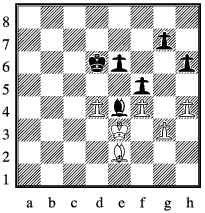
|
| Fuller v Clifford after 49 ... Be4
|
There seemed no reason to overrule the captain's decision to allow continuation - it is hard enough to get captains without unnecessarily overruling them, and in this case both players were content that their positions had not deteriorated during the moves subsequent to the claim. Having heard the testimony of players and captains, which in truth contained nothing unexpected, Roger saw no reason to change his opinion, so the provisional ruling of draw stands.
The rule 10.2 is quite clear: "If the arbiter agrees the opponent is making no effort to win the game by normal means, or that it is not possible to win by normal means, then he shall declare the game drawn." By definition whatever the arbiter's opinion is is correct. Consequently it is no surprise that there is no appeal. Yet I confess that if the player's had found themselves subjected to my opinions the ruling would have been loss for the claimant.
Why? First I backtrack to the position (left) immediately after the exchange of queens, soon after which the claim had been made.
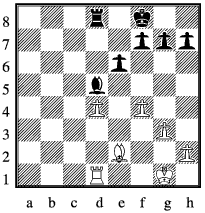
|
| Fuller v Clifford after 35 Bxe2
|
The remaining moves were
35 ... Bb3, 36 Rd2 f6, 37 Bf3 Bc4*, 38 Be2 Rc8, 39 Kf2 Ke7
40 Bd3 h6, 41 Rb2 Rc7, 42 Bg6 f5, 43 Bh5 Ra7, 44 Rc2 Ra2
45 Rxa2 Bxa2, 46 Ke3 Kd6, 47 Bf3 Bc4, 48 h4 Bd5, Be2 Be4
* I suspect that the apparently strange behaviour of both players on move 41 are best explained by black's 37th move having been Bd5, with a recording error being made, though both players admitted that the double blunder could have happened without them noticing.
White has kept the bishops on with his opponent having a couple of pawns fixed on the same coloured squares, and has moved his king towards the action. These are not random moves, but show intent to seek a win. He is trying.
Is it possible for white to win by normal means? There is a danger that if you start with "if white does this, then black can do that" that you will end up looking at best play for both sides and so make an adjudication. Thus my preference is simply to find some wins and ask if they can be considered by normal means or require abnormal co-operation from the claimant.
50 g4 is the obvious move for white, giving black the chance of an immediate blunder with fxg4 losing the bishop.
There are other losses lurking in reply to g4, some are:
50 ... Kd5, 51 Ba6 fxg4 not noticing that Bb7+ wins the bishop, a variation on the previous blunder.
50 ... Bb1, 51 Bf3 occupying the long diagonal
51 ... fxg4, 52 Bxg4 Bf5, 53 Bxf5 exf5. Black has one pawn island to white's three yet is lost after Kd3. A good end-game study consists of the position after 54 h5 instead of Kd3 in this line - it is then easy to find wins for both sides as well as draws. Finding these is educational.
50 ... g6, 51 g5 h5 locking the pawns
52 Kd2 moving towards the open spaces on the queenside
52 ... Kd5 to tie the white king down to the defence of the d-pawn
53 Bxh5 1-0
I'm not convinced that any of these can be dismissed as not being by normal means as even piece blunders do happen in normal chess. Thus I reckon it is possible for white to win by normal means, so to me the draw is not proven - I wouldn't take it that black's previous defence could be taken to mean that he would defend successfully against g4. Roger's feeling was that as he had no reason to suppose that g4 would definitely be played he couldn't take the possibility into account - looking at particular moves would constitute adjudication.
Where does this leave us. Meir are unhappy. I sympathise.
Have Holmes Chapel got away with one? I think not, for the expression implies intent to escape with more than their just desserts. It is entirely reasonable for Paul Clifford to have thought the position dead; one of the joys of the game is the way in which a sequence of apparently innocuous moves can have a sting in the tail. Particularly under time pressure a player can miss some of the possibilities. So no complaints about the claim having been made.
What have we learnt? Not a lot. Rather like synchronised swimmers who only know whether their routines have passed muster when the judges pronounce, those present at the meeting came away with no way of judging for themselves whether a position justifies a claim. Those coaches who teach their charges that they should claim if they have less than two minutes left on their clock and don't think they are winning are vindicated. Claim, you might get a draw; don't claim and you'll lose on time. Rather like the "have you noticed you're winning" draw offers beloved of juniors, claims made on the off-chance of success seem designed to create annoyance and bad feeling. We should be discouraging them.
comment on this article
Thurs 10th: Facing the music
Playing conditions are variable, not only have I played in three different rooms at their venue, but the background noise levels vary from almost non-existent to distinctly intrusive. Newcastle's match in the first division was conducted against a background of 'music' designed to ignite the ire in anyone blessed with grumpy old man genes. That this noise was more foreground than background was hardly conducive to concentration. John Booth was my immediate opponent, only he knows whether he enjoyed the home 'advantage'.
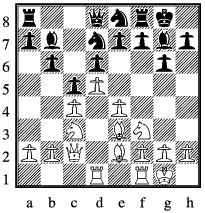
|
| RR v John Booth after 11 d5
|
As we join the game (left) RR has a small central space advantage.
11 ... Ne5, 12 Nxe5 dxe5 It is interesting how different the views of the two players involved in a game can be of the positions arising therein. As white I felt I had a significant edge which should be convertable to a win, even if there would be plenty of chances to go wrong in attaining that goal. John revealed after the game that this is where he thought he got on top.
13 Bg4 Immediately going down the wrong path. The bishop is doing a good job supporting the c-pawn where it is. Time to initiate a queenside expansion with a3.
13 ... Nd6, 14 b3 Note that 13 a3 could have been followed by b4 in response to the knight move, forcing the focus of the game onto the queenside. Instead John is able to start operations on the kingside.
14 ... f5, 15 exf5 gxf5, 16 Bh3 Bc8, 17 f4 e4
Black's passed pawn is not going anywhere soon, so white is comfortable and can set about deciding where he want's his pieces, and getting them there. Unfortunately consistency of plan is not always RR's strongpoint, tonight would prove a case in point.
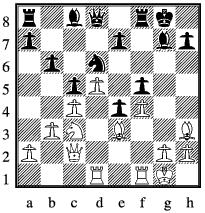
|
| RR v John Booth after 17 e4
|
18 Ne2 Qe8, 19 Kh1 h5, 20 g3 Feeble. h5 discourages white from bringing his knight to g3 in accordance with his plans, but the bishop on h3 makes it impossible for black to effect an attack agaist a g2 pawn. A g3 pawn is a different matter. It seems as if RR is determined to undermine the efforts of his own light-squared bishop.
20 ... Bd7, 21 a4 a5 RR puts the queenside out of commision. Why?
22 Nc3 Rf6, 23 Rd2 Kh7, 24 Rg1 Qf7, 25 Nd1 Rh8
26 Bf2 Kg8, 27 Ne3 Kf8, 28 Be1 Rg6, 29 Re2 Bd4
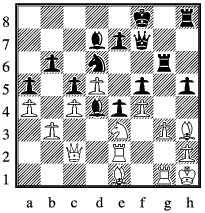
|
| RR v John Booth after 29 ... Bd4
|
The continual background din is getting to RR, and he is only considering the shallowest plans with minimal calculation. Can we just finish the game and go home?
30 Bc3 Qf6, 31 Bxd4 Even a casual inspection of consequences would have led to a different choice.
31 ... cxd4 This is horrible for white. But I hate resigning. Can I rescue anything from this wreckage?
32 c5 d3, 33 Qd2 dxe2, 34 cxd6 exd6, 35 Ng2 Seeking to prevent h4. Qxe2 would also achieve this by allowing g4 as a response to h4 at the price of allowing Qc3 Clearly I must keep the queens on. Nc4 would perhaps have shown some aggression. With the material advantage John had no need for sacrificial attacks and soon had me on the brink.
35 ... Ke7, 36 Nh4 Rgg8, 37 Qxe2 Rc8, 38 Qe3 Rc5, 39 Bf1 Rxd5
40 Qxb6 Rc8, 41 Qe3 Qb2, 42 Rg2 Qc1, 43 Qe2 Rd1, 44 Rg1
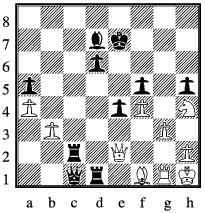
|
| RR v John Booth after 44 ... Rc2
|
44 ... Rc2, 45 Qxh5 any better suggestions?
45 ... Rxf1 Mate looms, but John has gone for it too quickly!
46 Qg5+ Provided white does not allow the black king onto d8 or d5 he has a perpetual. A draw by repetition came on move 52.
comment on this article
Fri 18th: Going astray
It is some time since RR last played Roger Edwards, a player against whom his record is probably no better than 50-50. Early queenside expansion and an exchange of pawns on b4 left RR with an isolated a-pawn but a b-pawn to target. Not much in it either way.
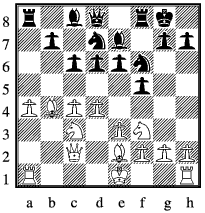
|
| RR v Roger Edwards after 11 Bxb4
|
11 ... d5 Unexpected - though c5 was coming. Can take dark squared bishops off, which should give me the advantage through a better light squared one.
12 Bxe7 Qxe7, 13 0-0 Ne4, 14 Rfb1 g5 A sober assessment says this attack is going nowhere. RR was sober, but his assessment was not, so instead of continuing his queenside plans with a5, RR allowed his play to be diverted. A common way of strengthening one's opponent's hand.
15 Ne5 Nxe5, 16 dxe5 g4, 17 Nxe4 fxe4, 18 Bxg4 This is the bad move in the sequence: white's e-pawn is more important than blacks g-pawn.
18 ... Qg5, 19 Bh3 Qxe5, 20 Qb2 Not sure what I think black's queen will do, so why exchange?
20 ... Qxb2, 21 Rxb2 Rf7. Roger's turn to choice an inferior line. dxc4 and b5 is unhealthy for white to face.
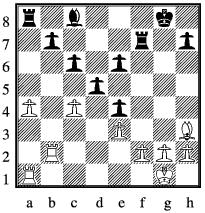
|
| RR v Roger Edwards after 21 Rf7
|
22 Rd2 Re7, 23 Raa2 Kf7 with draw offer.
RR has no concrete ideas of how to pursue victory from here, indeed there seems no reason to suppose he should despite having more mobile pieces. However the team line-ups suggest that this is a board the club needs to win following a quick loss elsewhere, so play on is the response.
24 a5 Kf6, 25 g3 Ke5, 26 Bf1 c5, 27 cxd5 gifting a significant advantage to black. Rdb2 would discourage d4:
27 Rdb2 d4, 28 exd4 cxd4 (Kxd4 leaves black with shattered pawns), 29 Rb5+ with Bg2 to follow wins white a pawn.
27 ... exd5, 28 Rdc2 Kd6, 29 Rcb2 Kc7
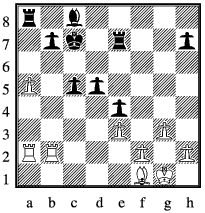
|
| RR v Roger Edwards after 29 ... Kc7
|
29 Rb6 Rxa5, 30 Rxb7+ Bxb7, 31 Rxa5
RR now found himself retreating, and by move 41 the position (right) had been reached.
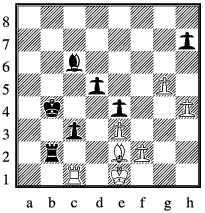
|
| RR v Roger Edwards after 41 g5
|
41 ... Kb3
RR's remaining chances lie with his kingside pawns. Be8 would have put paid to them. RR ignores the lifeline and plays Bd1?? Despite playing on for another 20 moves, RR finally admitted that his king had too many squares for his king to secure stalemate and resigned.
Yet 42 h5 and black has to be careful. eg
42 ... c2, 43 Kd2 and white is winning.
42 ... Ra2, 43 Bd1+ c2, 44 Rxc2 and black cannot take the pieces off and stop white queening. So black has to retreat on move 43.
There are of course plenty of safe lines for black, but whether any of them is winning for him is another matter. For once RR fails to do a Houdini.
comment on this article
Wed 23rd: (Almost) nothing happened
RR was in a decidedly unambitious mood as he sat down to face Simon Edwards, partly because of his own recent inadequate play, and partly due to Simon's superior status. We join the game 9 moves in, with RR having white's usual small edge, in this case manifested by control over e5 and a lead in development.
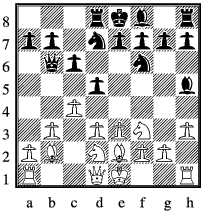
|
| RR v Simon Edwards after 9 Nbd2
|
9 ... Bg6 Is Simon eyeing an attack down the h-file? Don't know, but with a subsequent h6 allowing him maintain his bishop RR decides it is time to act.
10 Nh4 dxc4, 11 Nxg6 hxg6, 12 Nxc4 Qb4+, 13 Qd2 Qxd2+, 14 Nxd2 Nc5
15 d4 Nce4, 16 Nxe4 Nxe4, 17 Bd3 Nf6, 18 0-0-0 e6 The bishop pair and superior pawn structure should give RR a plus worth pursuing, starting with a3 (keep black's bishop at bay) and e4 (keep knight out of d5), but RR elects to keep his pawn structure as is, and soon finds himself giving up his own bisop pair.
19 Kb1 Nd5, 20 Be4 (e4 Nf4 causes white no lasting problems)
20 ... Bb4, 21 Bxd5 cxd5 ½ - ½
21 Rc1 can be met with Kd7 and the rooks all come off. Either player could then play on in the hope that their opponent goes wrong, but with a couple of fixed dark square pawns RR may find he is the one needing to take more care.
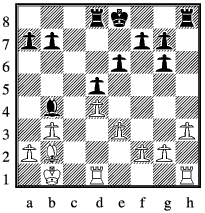
|
| RR v Simon Edwards final position
|
comment on this article
Sat 26th: Quickie
Cheddleton were in barrel scraping mode for their 4NCL match against Bradford B, so yours truely got roped in, and found himself the proud possessor of the white pieces. Bxf7+ on move 5 won RR a pawn and left black unable to castle. Although there was no knock-out blow to follow, by move 18 black had had enough. 'Twas not a pretty sight, so I have drawn a veil over the details.
comment on this article
Mon 28th: Whoops!
Clive Ferry had white against RR when Newcastle visited Meir for a second division match. We both avoided the opening books like the plague, and reached the diagrammed position with Clive settling on a plan of queenside expansion, which incidently meant that black's knight reached c7 taking the scenic route from b8 via d7, b6 and a8. RR's position is reasonably sound however even though he is not setting the pace.
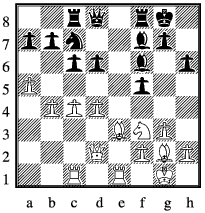
|
| Clive Ferry v RR after 19 ... Nc7
|
20 d5 cxd5, 21 cxd5 Nb5
I didn't like the look of
21 ... Nxd5, 22 Bxa7 as I felt that this would leave my d-pawn vulnerable and free up his bishops to support the further advance of his a/b pawns, missing 22 ... Bc3 gaining me some material compensation for this.
22 Qd3 Qd7, 23 Nd4 Bxd4, 24 Bxd4 Rfe8 ... Nxd4 surely required, though I had vague ideas that I could reach a minor piece ending with my knight and bishop ganging up on d5.
25 Rxc8 Rxc8, 26 Bb2 memo to self: make sure you can guard against mate on the long diagonal
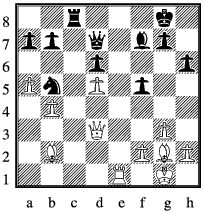
|
| Clive Ferry v RR after 26 Bb2
|
26 ... a6, 27 Qe3 Kf8 Feeble. Attack with Rc2 or Rc4, or even take some major pieces off with Re8.
28 Qd2 Rc7 adds second rank protection,
29 Bf1 Rc8 removes second rank protection
30 Bxb5 Qxb5, 31 Qd4 1-0
What happened to that memo?
comment on this article
Weds 30th: Time please
The return match against Alsager A saw RR paired with Julian Kirk O'Grady. We refused to engage forces until move 12.
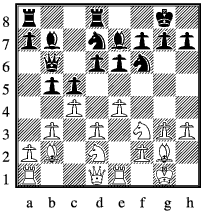
|
| Julian Kirk O'Grady v RR after 12 c4
|
12 ... a6, 13 Qc2 e5 definitely in a boring for England mode today.
14 Nf1 Nb8 Nf8 a more flexible way of aiming for d4. Plenty more manoeuvring to come.
15 Ne3 Nc6, 16 Nd5 Nxd5, 17 exd5 Nd4, 18 Nxd4 cxd4
19 a4 Qc7, 20 Qe2 bxc4, 21 bxc4 Bf8 mainly to prevent accidents to this piece.
22 a5 Bc8, 23 Ba3 Rb8, 24 Qd2 Bf5, 25 g4 Bg6
I feel RR has now gained a slight edge. both sides have a bishop hitting a backward pawn, but black also has a rook on the open b-file.
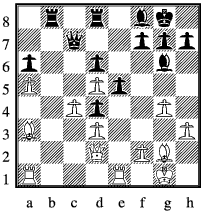
|
| Julian Kirk O'Grady v RR after 25 ... Bg6
|
26 Bf3 Rb3 taking full control of the b-file
27 Be4 Bxe4, 28 Rxe4 Rdb8, 29 Ree1 Qd8, 30 Kg2 Qf6
31 Red1 Qg6, 32 Qe2 f5, 33 Qf3 e4 Although this creates a passed pawn it is not best calculated. A simple f4 leaving white short of threatening continuations is better.
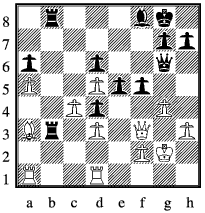
|
| Julian Kirk O'Grady v RR after 33 Qf3
|
34 Qxf5 Qxf5, 35 gxf5 exd3, 36 Bc1 R8b4
We had both used quite a bit of our time to get this far, so the endgame needed to be played out relatively quickly, which with loose pawns all over the board could be a problem. Don't expect too much best play! Suffice to say that Fritz has us both with a clear edge at points in the subsequent play. Move 62 arrives and neeither side can make further progress - see diagram.
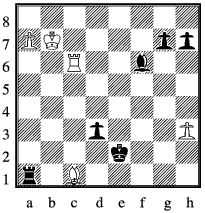
|
| Julian Kirk O'Grady v RR after 62 Kb7
|
If 62 Rb1+ is met by Rb6, then 63 ... Rxb6, 64 Kxb6 Bd4+ and the position is a simple win for black. So nothing here for white. But RR sees the slighest glimmer that Julian will go wrong. A few seconds checking that the ending when Julian goes right is drawn and the game ends:
62 ... d2 simple and correct, 63 Bxd2 Rxa7+, 64 Kxa7 Kxd2
and RR loses on time. those few seconds taken checking that he could draw this position meant he didn't have time to do so!
comment on this article





















